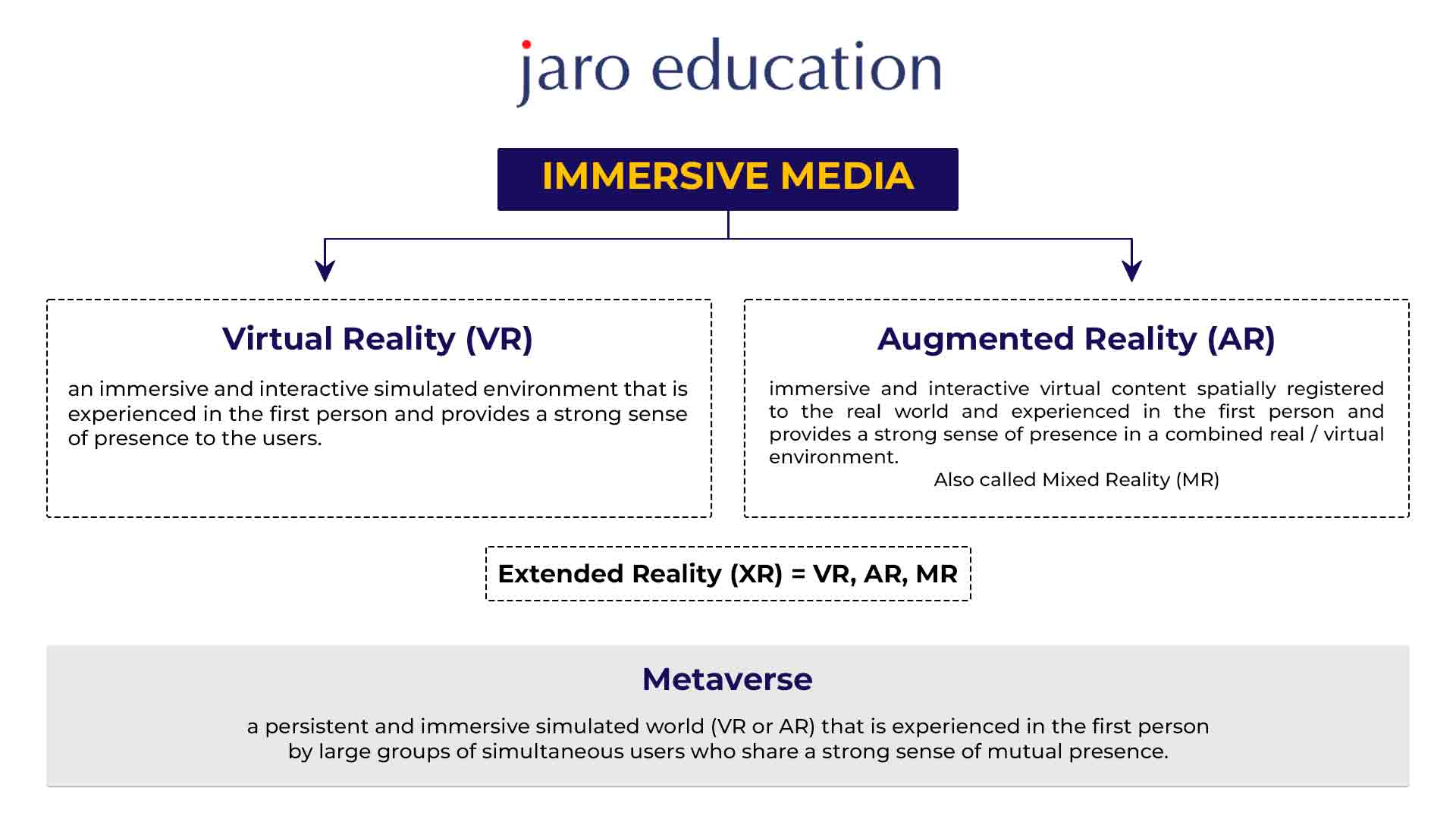
Virtual reality (VR) and augmented reality (AR) are frequently used interchangeably as they are quite similar. We may view a virtual world using AR and VR that appear clear and realistic but are slightly different from our own. They employ unique displays that are right before our eyes.
AR and VR are paving the way for several new applications in various industries. Therefore, it is accurate to claim that AR and VR technology share many similarities. But they also differ from one another in a few ways that set them apart.
The Master of Computer Applications Program offered by Amity University Online can help you understand how AR and VR are generating novel opportunities across numerous industries. This concise explanation seeks to clarify the major differences between AR and VR while assisting you in understanding their intriguing variants.
Understanding Augmented Reality
Augmented reality (AR) is a refined and interactive experience that takes your real-world experience to the next level with perpetual information generated from computing devices. It overlays computer-generated images over the real environment so you can view them through various devices, such as phones or glasses. A large head-covering headgear may be recommended to view such images and videos but not in all cases.
AR takes our images of our surroundings and adds interesting digital elements like music, colourful hues, and visuals. It’s like using technology to paint over reality. Although AR closely resembles the natural environment, it also contains these additional digital elements. People use AR for a variety of purposes, including virtual tutoring and assisting with particular forms of therapies.
Table of Contents
Understanding Virtual Reality
You may have heard of virtual reality in online games. Virtual reality (VR) is a specific form of technology that enables us to have a simulated experience in three dimensions. Utilizing VR, people are constantly creating new and improved video games to improvise experience and give a real-world feel to a world that does not exist.
Similar to augmented reality, virtual reality (VR) displays incredibly detailed, photorealistic computer-generated images. You can accomplish this by using eye-covering headsets or specific eyewear. Similar to AR, these photos have digital features, including noises, colours and brightness.
Currently, you can find three different variations of virtual reality simulations:
- Non-immersive Virtual Reality
- Semi-immersive Virtual Reality and
- Fully immersive Virtual Reality
These variations differ according to the experience they provide to the users. While non-immersive experiences are common and sometimes aren’t considered VR, fully immersive VR takes you to a whole new world with a visual and audio experience like real life. On the other hand, semi-immersive VR will help you indulge in an experience with a few experiences portraying a virtual reality environment and others being similar to non-immersive VR experiences.
Augmented Reality vs Virtual Reality
When exploring the world of technology, it is critical to understand the key differences between AR and VR. Here is a close account of the comparison of Augmented Reality vs Virtual Reality.
| AR | VR |
|---|---|
| The use of augmented reality (AR) enhances what you see in the actual world. | Virtual reality (VR) creates a new universe, taking you to a whole new world. |
| A 100 Mbps internet connection is needed for AR. | A 50 Mbps internet connection is required for VR. |
| AR focuses primarily (75%) on the real world and (25%) on the virtual world. | Virtual reality (VR) focuses primarily (75%) on the virtual world and less (25%) on the real world. |
| You take a small part in the action when using AR. | You are completely immersed in the action when using VR. |
| You remain in touch with the actual world while using augmented reality. | In virtual reality, you are entirely in a different world from reality. |
| AR is utilized to improve both virtual and real-world objects. | VR is frequently utilized to enhance the fun and excitement of video games. |
| AR allows you to interact with virtual objects while remaining in the real world. | Virtual reality entirely shunts you out of reality and navigates you into a fictional one. |
| It can be used without a specialized AR. headset. | For VR, a headset is needed. |

*Bigthink.com
How Augmented Reality (AR) Works?
Specialized mapping, depth monitoring, and vision algorithms are used in augmented reality (AR). These technologies allow cameras to gather and interpret data to show the right digital material depending on an individual’s viewpoint.
Simply put, AR improves your present-time vision by incorporating digital components into the environment. You can experience this using a cell phone or other specialized gadgets that add digital upgrades to your surroundings to make them more interesting. By seamlessly fusing innovative digital elements with real-world experiences, AR enhances your perspective of reality, whether using your mobile device to examine details about a location or adding virtual objects to your surroundings.
What are the AR Benefits?
Augmented Reality (AR) offers many benefits that improve our experiences in various areas. Some of the most important ones are:
Customized Educational Experiences
AR provides individualized educational opportunities that adjust to user needs and choices.
Enhancement of the Learning Process
With AR, the learning experience, in general, improves. It can seamlessly make the process more interactive and engaging.
Ability to Adapt Across Industries
Numerous industries, including entertainment, healthcare, and education, extensively use augmented reality, because of its features and benefits.
Encourages Improvement and Innovation
By continually enhancing its features and capabilities, AR promotes innovation.
Improvements in Accuracy and Precision
Accuracy and correctness are increased with AR in various tasks and activities.
User Empowerment Education
AR gives users more authority by offering entertaining and relevant educational information.
Enables Shared Experiences Beyond Distance
Even when geographically apart, people may interact and share experiences, thanks to the development of AR.
Supports Game Developers
Game developers benefit from AR’s ability to create immersive and realistic gaming experiences.
Applications of Augmented Reality (AR)
AR Apps
With the use of augmented reality (AR) apps, you may add more information and visual components to your experience by superimposing text, photographs, videos, and other digital content over your real-world perspective.
Advertising and Printing
The printing and advertising industries use augmented reality to display digital content on printed periodicals and adverts, giving viewers a dynamic and engaging experience.
Translation Assistance
Language translation apps use AR technology to translate text from one language to another automatically. By enhancing communication and understanding, this practical application elevates the importance of AR for intercultural engagement.
3D Games
Games with real-time 3D effects are produced by AR utilizing tools like the Unity 3D Engine.
How Does Virtual Reality Work?
The primary objective of Virtual Reality (VR) is to make anything appear real. For instance, let’s take an example of the images shown on the display originating from a computer or mobile device that are linked by a specific cord. With the use of various speakers, lenses, and even handheld devices, you get the feeling that you are genuinely residing in the made-up universe with the help of these components. This is the power of VR. So, in virtual reality, you may view, understand, and sense things, giving the impression that you are actually there.
Benefits of VR
As technology advances, the benefits of VR are expanding and improving experiences in numerous industries. The following are some advantages of virtual reality:
Engaging Environment
The extremely dynamic learning environment created with virtual reality makes learning more interesting and enjoyable. Using it to improve your work abilities may increase your performance and become more competent and effective.
Interaction with Reality
Its capacity to create an authentic environment for users to discover and learn about it, is one of its primary features.
Interactive Education
Through the ability to interact and explore an environment that feels genuine, virtual reality improves the experience. This method helps students learn more effectively and comfortably in the classroom.
Artificially Created Experiential Environment
Users can learn new things and expand their knowledge via virtual reality without worrying about how their actions would affect the physical environment.
More Convenience
When users use this technology, it makes a daunting task even simpler and easier, hence enhancing their access to a range of activities.
Applications of Virtual Reality
The usage of virtual reality is changing how people communicate, learn, and experience their surroundings in several different sectors.
Adventures of Gaming
Virtual Reality makes the dream realms of video games more pleasurable.
Military Training
Military personnel can use virtual reality to practise computerized imitation of flying aircraft and fighting battles.
Sports Training
VR develops athletes and monitors their performance.
Therapeutic Tool
VR, as a therapeutic tool, aids in the treatment of PTSD and phobias.
Immersive Activities
You can experience diverse locations by using VR tools like Google Cardboard or Oculus Rift.
Medical Practice
Virtual reality patients are used to teach and train medical students.
How do AR and VR Collaborate?
It’s important to understand that AR and VR aren’t meant to work separately from one another. Instead, they typically cooperate to create an experience that is more stimulating. The user is given the sensation that they are in a brand-new universe that is both fictional and real when these breakthroughs come together. The interaction of the actual and virtual worlds improves the experience by creating a space where fantasy and reality collide, and the boundaries between them are blurred by technology. Users can go on an incredibly engaging trip with the perfect blending of the real and virtual worlds.
Thus, comprehending the difference between AR and VR can help you understand how these amazing technologies work. While VR builds entirely new fantasy realms, AR adds digital components to the physical world. Each has a unique function, such as enhancing learning through games or assisting in training warriors. Understanding the differences between AR and VR can help you appreciate how technology alters our experiences.








